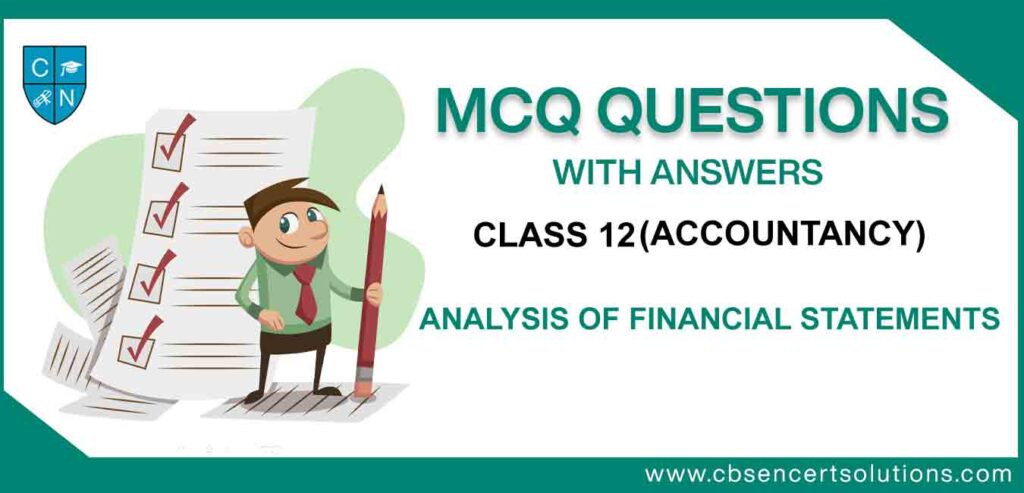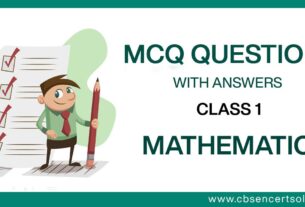Check the below NCERT MCQ Class 12 Accountancy Chapter 4 Analysis of Financial Statements with Answers available with PDF free download. MCQ Questions for Class 12 Accountancy with Answers were prepared based on the latest syllabus and examination pattern issued by CBSE, NCERT and KVS. Our teachers have provided below Analysis of Financial Statements Class 12 Accountancy MCQs Questions with answers which will help students to revise and get more marks in exams
Analysis of Financial Statements Class 12 Accountancy MCQs Questions with Answers
Refer below for MCQ Class 12 Accountancy Chapter 4 Analysis of Financial Statements with solutions. Solve questions and compare with the answers provided below
Question: Importance of Comparative Statement is
a) All of the options
b) Make the data simple and more understandable
c) Indicate the trend with respect to the previous year
d) compare the firm performance with the performance of other firm in the same business
Answer
All of the options
Ques. When bad position of the business is tried to be depicted as good, it is known as …………….
(A) Personal Bias
(B) Price Level Changes
(C) Window Dressing
(D) All of the Above
Answer
Window Dressing
Question: The Real object of Analysis of Financial Statement is
a) To measure the financial strength of the business
b) To assess the total expenses of the firm
c) To know about historical cost concept
d) To assess the total liabilities of the firm
Answer
To measure the financial strength of the business
Question. The financial statements of a business enterprise include :
(a) Balance sheet
(b) Statement of Profit and loss account
(c) Cash flow statement
(d) All the above
Answer
(d) All of the above
Question. Main limitation of analysis of financial statements is
(A) Affected by window dressing
(B) Difficulty in forecasting
(C) Do not reflect changes in price level
(D) All of the Above
Answer
All of the Above
Question. While preparing Common-size Balance Sheet, each item of Balance Sheet is expressed as % of
(a) Current Assets.
(b) Non-current Assets.
(c) Non-current Liabilities.
(d) Total Assets.
Answer
Total Assets.
Question. Which of the following is a type of Financial Analysis on the basis of material used ?
(a) Internal Analysis
(b) External Analysis
(c) Internal Audit
(d) Both (a) and (b)
Answer
Both (a) and (b)
Question: In which analysis Financial Statement for a single year analysed
a) Vertical Analysis
b) Dynamic Analyses
c) Vertical Analysis and Dynamic Analyses
d) None of the options
Answer
Vertical Analysis
Question: To whom Importance of Financial Analysis is
a) All of the options
b) For Management
c) For Investors
d) For Creditors
Answer
All of the options
Question. Main objective of Common Size statement is :
(A) To present the changes in various items
(B) To provide for a common base for comparison
(C) To establish relationship between various items
(D) All of the Above
Answer
All of the Above
Question. The most commonly used tools for financial analysis are :
(a) Horizontal analysis
(b) Vertical analysis
(c) Ratio analysis
(d) All the above
Answer
(d) All the above
Question. What is shown by Balance Sheet ?
(a) Accuracy of books of accounts
(b) Profit or loss of a specific period
(c) Financial position on a specific date
(d) None of the above
Answer
C
Question: Rent received, Profit on sale of fixed assets, Compensation for acquisition of land are example of
a) Non-operating Incomes
b) Operating Incomes
c) Operating expenses
d) None of the options
Answer
A
Question. In the Statement of Profit & Loss of a Common Size Statement:
(A) Figure of net revenue from operations is assumed to be equal to 100
(B) Figure of gross profit is assumed to be equal to 100
(C) Figure of net profit is assumed to be equal to 100
(D) Figure of assets is assumed to be equal to 100
Answer: A
Answer
A
Question: each item is expressed as a percentage of some common base in
a) Common size statement
b) Fund Flow Statement
c) Cash Flow Statement
d) Cash Flow Statement
Answer
Common size statement
Question: Importance of Comparative Statement is
a) All of the options
b) Make the data simple and more understandable
c) Indicate the trend with respect to the previous year
d) compare the firm performance with the performance of other firm in the same business
Answer
All of the options
Question. Comparative statements are also known as :
(a) Dynamic analysis
(b) Horizontal analysis
(c) Vertical analysis
(d) External analysis
Answer
(b) Horizontal analysis
Question: Common size analysis is also known as ______ Analysis
a) Vertical
b) Vertical
c) Vertical
d) None of the options
Answer
Vertical
Question The analysis of financial statement by a shareholder is an example of:
(a) External Analysis
(b) Internal Analysis
(c) Vertical Analysis
(d) Horizontal Analysis
Answer
External Analysis
Question. Which objective is not fulfilled by comparative financial statement:
(A) Indicate the extent of change in assets and liabilities
(B) Indicate the extent of change in items of Statement of Pofit & Loss
(C) Show effect of operative activities on assets and liabilities
(D) Show the direction of change in assets and liabilities
Answer
Indicate the extent of change in items of Statement of Pofit & Loss
Question. When bad position of the business is tried to be depicted as good, it is known as …………….
(A) Personal Bias
(B) Price Level Changes
(C) Window Dressing
(D) All of the Above
Answer
C
Question. The most commonly used tools for financial analysis are :
(A) Comparative Statements
(B) Common Size Statements
(C) Accounting Ratios
(D) All of the above
Answer
D
Question: Ratio analysis establishes relationship between
a) Two financial statements
b) Two Share Holder
c) Two Debentures Holder
d) None of the above
Answer
Two financial statements
Question: Financial year always begins on
a) 1st April-31st March
b) 1st January-31st December
c) 1st August -31st July
d) None of the options
Answer
1st April-31st March
Question. Financial analysis become useless because it:
(A) Measures the profitability
(B) Measures the Solvency
(C) Lacks Qualitative Analysis
(D) Makes a comparative study
Answer
C
Question: each item is expressed as a percentage of some common base in
a) Common size statement
b) Fund Flow Statement
c) Cash Flow Statement
d) Cash Flow Statement
Answer
A
Question: The analysis of financial statement by a shareholder is an example of:
(a) External Analysis
(b) Internal Analysis
(c) Vertical Analysis
(d) Horizontal Analysis
Answer
A
Question: Bring out the importance of Financial Analysis
a) All of the options
b) Helps in evaluating the profit earning capacity and financial feasibility of a business
c) Helps in evaluating the profit earning capacity and financial feasibility of a business
d) Helps in evaluating the relative financial status of a firm comparison to other competitive firms
Answer
All of the options
Question: Interpretation of Financial Statements includes:
(a) Criticisms and Analysis
(b) Comparison and Trend Study
(c) Drawing Conclusion
(d) All the above
Answer
D
Question: Common size statements can be classified into which broad categories
a) Common size statements can be classified into two broad categories and Common Size Balance Sheet
b) Common size statements can be classified into two broad categories
c) Common Size Balance Sheet
d) None of the options
Answer
A
Question. In a common size Balance Sheet, total liabilities are assumed to be equal to
(A) 1
(B) 10
(C) 100
(D) 1,000
Answer
C
Question. Creditors or Suppliers are interested to know the
(a) Profitability of the firm in relation to turnover.
(b) Profitability of the firm in relation to investments.
(c) Short-term solvency/liquidity of the concern.
(d) Effective utilisation of its (firm’s) resources.
Answer
C
Question. Analysis of Financial Statements is significant:
(A) For Creditors
(B) For Managers
(C) For Employees
(D) For all of the above
Answer
D

We hope you liked MCQ Class 12 Accountancy Chapter 4 Analysis of Financial Statements with answers provided above. Incase you have any questions please post them in the comments section below and our Accountancy teachers will provide a response. Also read DK Goel Class 12 Solutions
